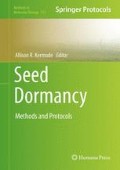Abstract
Activation tagging is an important tool for gene discovery in plants. This method utilizes a T-DNA sequence that contains four tandem copies of the cauliflower mosaic virus 35S enhancer sequence or promoters oriented outward to the T-DNA border sequences. These elements enhance the expression of genes neighboring on either side of the randomly integrated T-DNA, resulting in gain-of-function phenotypes. Activation tagging has identified a number of genes, including those fundamental to plant development, such as the floral inducer gene, FLOWERING LOCUS T (FT ). The methods surrounding activation-tagging approaches are described in this chapter. While seeds have generally not been the targets of these methods in the past, activation tagging provides a powerful approach to uncover genes involved in seed dormancy and germination, including those that mediate hormone signal transduction.
Access this chapter
Tax calculation will be finalised at checkout
Purchases are for personal use only
References
Weigel, D., Ahn, J. H., Blazquez, M. A., Borevitz, J., Christensen, S. K., Fankhauser, C., Ferrandiz, C., Kardailsky, I., Malancharuvil, E. J., Neff, M. M., Nguyen, J. T., Sato, S., Wang, Z., Xia, Y., Dixon, R. A., Harrison, M. J., Lamb, C. J., Yanofsky, M. F., and Chory, J. (2000) Activation tagging in Arabidopsis. Plant Physiol. 122, 1003–14.
Pan, X., Li, Y., and Stein, L. (2005) Site preferences of insertional mutagenesis agents in Arabidopsis, Plant Physiol. 137, 168–75.
Schneeberger, R.G., Zhang, K., Tatarinova, T. et al. (2005) Agrobacterium T-DNA integration in Arabidopsis is correlated with DNA sequence compositions that occur frequently in gene promoter regions. Funct. Integr. Genomics. 5, 240–53.
Zuo, J., Niu, Q.W., Frugis, G., Chua, N.H. (2002) The WUSCHEL gene promotes vegetative-to-embryonic transition in Arabidopsis. Plant J. 30, 349–59.
Sung JQ, Niu QW, Tarkowski P, Zheng BL, Tarkowska D, Sandberg G, Chua NH, Zuo JR(2003) Plant Physiol. 131, 167–76
Tani, H, Chen, X., Nurmberg, P., Grant, J.J., SantaMaria, M., Chini, A., Gilroy, E., Birch, P.R., and Loake, G.J. (2004) Activation tagging in plants: a tool for gene discovery. Funct. Integr. Genomics 4, 258–66.
Aukerman, M.J., and Sakai, H. (2003) Regulation of flowering time and floral organ identity by a MicroRNA and its APETALA2-like target genes. Plant Cell 15, 2730–41.
Palatnik, J.F., Allen, E., Wu, X., Schommer, C., Schwab, R., Carrington J.C. and Weigel, D. (2003) Control of leaf morphogenesis by microRNAs. Nature 425, 257–63.
Salaita, L., Kar, R.K., Majee, M., and Downie, A.B. (2005) Identification and characterization of mutants capable of rapid seed germination at 10 8 C from activation-tagged lines of Arabidopsis thaliana. J. Exp. Bot. 56, 2059–69.
Koncz, C., Kreuzalerl, F., Kalmanl, Z., and Schell, J. (1984) A simple method to transfer, integrate and study expression of foreign genes, such as chicken ovalbumin and α-actin in plant tumors. EMBO J. 3, 1029–37.
Ooms, G., Regensburg-Tuink, T. J. G. Hofker, M. H., Hoekema, A., Hooykaas, P. J. J., and Schilperoort, R.A, (1982). Studies on the structure of cointegrates between octopine and nopaline Ti-plasmids and their tumor-inducing properties. Plant Mol. Biol. 1, 265–76.
Clough, S.J., and Bent, A.F. (1998) Floral dip: a simplified method for Agrobacterium-mediated transformation of Arabidopsis thaliana. Plant J. 16, 735–43.
Zhang, X., Henriques, R., Lin, S., Niu, Q., and Chua, N.H. (2006) Agrobacterium-mediated transformation of Arabidopsis thaliana using the floral dip method. Nature Protocols 1(2), 1–6.
Liu, Y. G., Mitsukawa, N., Oosumi, T., and Whittier, R. F. (1995) Efficient isolation and mapping of Arabidopsis thaliana T-DNA insert junctions by thermal asymmetric interlaced PCR. Plant J. 8, 457–63.
Ochman, H., Geber, A.S., and Hartl, D.L. (1988) Genetic application of an inverse polymerase chain reaction. Genetics, 120, 621–3.
Meza, T.J., Stangeland, B., Mercy, I., Skarn, M., Nymoen, D. A., Berg, A. Butenko, M.A., Hakelien, A., Haslekas, C., Meza-Zepeda, M., and Aalen, R.B. (2002) Analyses of single-copy Arabidopsis T-DNA-transformed lines show that the presence of vector backbone sequences, short inverted repeats and DNA methylation is not sufficient or necessary for the induction of transgene silencing. Nucleic Acids Res. 30, 4556–66.
Romit Chakrabarty,R., Rituparna Banerjee, R., Chung, S., Mark Farman,M., Citovsky, V., Hogenhout, S., Tzvi Tzfira, T., and Goodin, M. (2007) pSITE Vectors for Stable Integration or Transient Expression of Autofluorescent Protein Fusions in Plants: Probing Nicotiana benthamiana-Virus Interactions. Molecular Plant-Microbe Interaction 20, 740-50.
Curtis, M., and Grossniklaus, U. (2003) A Gateway TM cloning vector set for high-throughput functional analysis of genes in plants. Plant Physiol. 133, 462–9.
Brand L., Hoerler M., Nuesch E., Vassalli S., Barrell P., Yang W., Jefferson R.A., Grossniklaus U., and Curtis, M.D. (2006) A versatile and reliable two-component system for tissue-specific gene induction in Arabidopsis. Plant Physiol. 141, 1194–1204.
Acknowledgments
This research was supported by a Natural Sciences and Engineering Research Council of Canada (NSERC) Discovery grant awarded to A.R. Kermode.
Author information
Authors and Affiliations
Corresponding author
Editor information
Editors and Affiliations
Rights and permissions
Copyright information
© 2011 Springer Science+Business Media, LLC
About this protocol
Cite this protocol
Zhao, T., Zeng, Y., Kermode, A.R. (2011). Identification of Seed Dormancy Mutants by Activation Tagging. In: Kermode, A. (eds) Seed Dormancy. Methods in Molecular Biology, vol 773. Humana Press. https://doi.org/10.1007/978-1-61779-231-1_12
Download citation
DOI: https://doi.org/10.1007/978-1-61779-231-1_12
Published:
Publisher Name: Humana Press
Print ISBN: 978-1-61779-230-4
Online ISBN: 978-1-61779-231-1
eBook Packages: Springer Protocols

